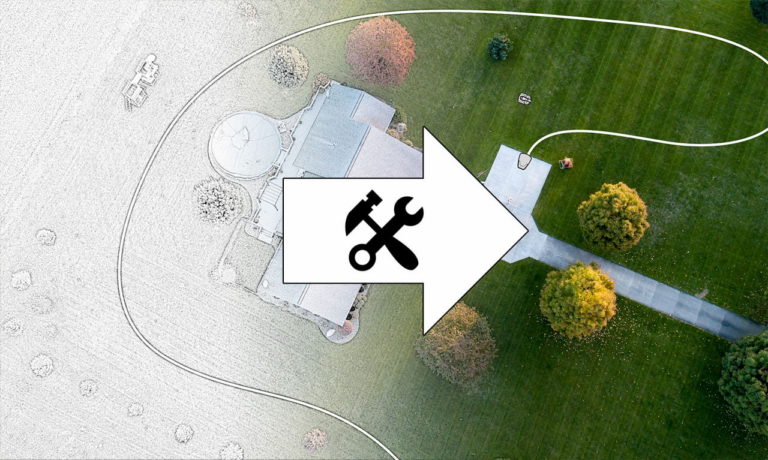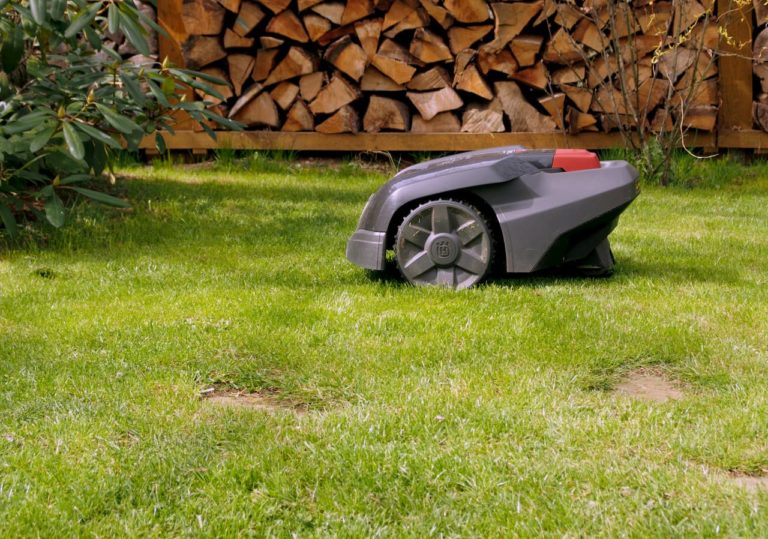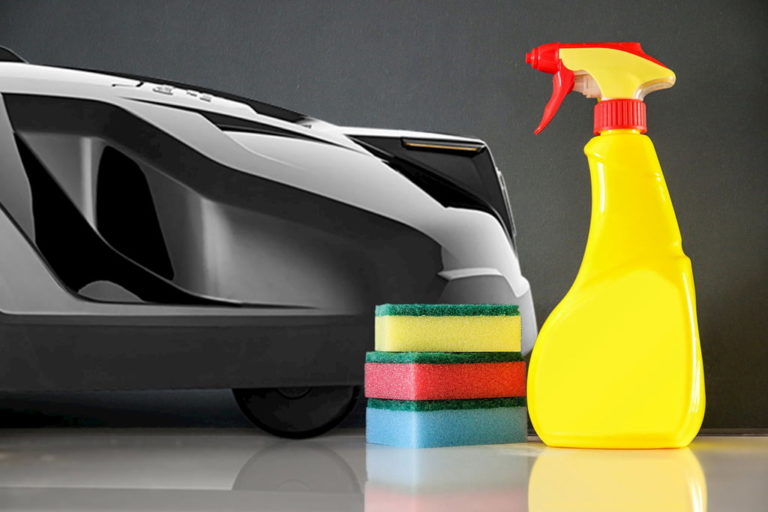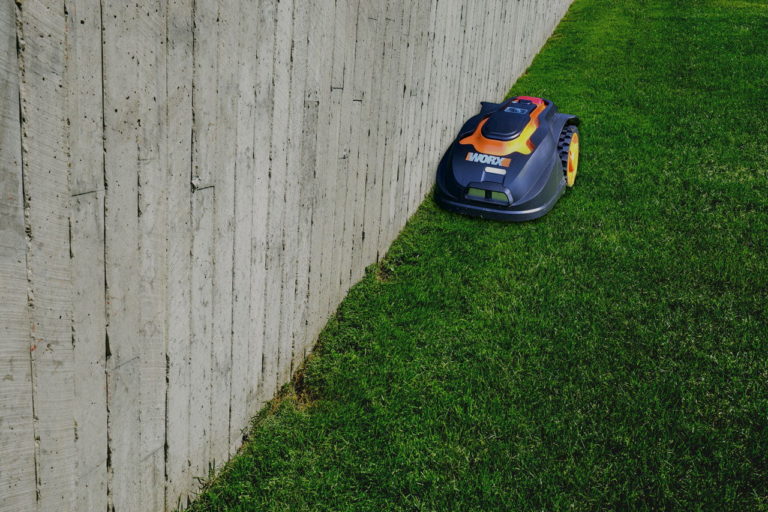Most robotic mowers mow your yard at random. They drive all around the lawn until they have hit every spot at least once, like a sheep grazing at pasture. What is the theory behind this method? Is it really all random?
How does the random mowing method work with the robotic mower? When mowing at random, the robotic mower always drives straight ahead until it encounters an obstacle or the boundary wire. When it comes upon an obstacle, the mower makes a U-turn. A complex algorithm determines via a combination of randomness and statistics how much the robotic mower turns.
So is it completely random, how the robotic mower drives through the yard, or not? How can it even know that it has hit every spot? And are there any other techniques besides the “chaos method”? I have taken the trouble here to shed some light on this.
Contents
How does random mowing work and is it really completely by chance?
When mowing “randomly,” the robotic mower drives through your yard in a seemingly chaotic pattern. The idea is: “If I drive all over the place, I’ll eventually get every spot. The robotic mower simply drives straight ahead until it encounters an obstacle or the boundary wire, which it then tries to avoid.
There it will make a U-turn and continue straight ahead in another direction until it encounters another obstacle or the boundary wire again, or until it notices that it is running out of juice and needs to return to the charging station.
The problem with chaotic mowing
However, this chaotic mowing principle has a problem: certain areas are covered more frequently and others less frequently. In a square yard, you can certainly imagine this. The areas in the middle get driven over quite frequently, while areas closer to the edge are run over less often, as the probability is simply smaller that the robotic mower will get there.
And if you then imagine a very winding yard, with longer corridors and narrow corners, you can certainly imagine that these places are even less frequented.
In addition, it is of course not desirable if a certain spot is run over so often it becomes more or less permanently run-down.
However, the fact that certain spots are run over several times is something that, to a certain extent, is not really a problem at all. It is precisely because the lawn is mowed several times from different directions within a short period of time, rather than always from the same direction, that it gets a better cutting pattern and no stripes appear on the lawn.
The robotic mower mows chaotically with a system in mind
Above all, however, the robotic mower does not really mow completely at random. The robot’s software has an algorithm that uses statistics to calculate an ideal, optimized random method. This then controls, for example, by how many degrees the robotic mower turns on the boundary wire each time.
This is an attempt to reduce the incidence of the aforementioned problem of the mower over-frequenting a certain spot. The robotic mower should preferably drive over every part of the lawn more or less equally as often and from different directions.
The software can draw on additional information that it obtains from various sensors. Not only the impact sensors of the robotic mower and the shock sensor help it, but also a compass, an incline sensor and a counter that counts the wheel revolutions.
The software employed is of course different from manufacturer to manufacturer, and can be more or less refined. But the goal is always to control the robotic mower “by chance” in such a way that it mows the lawn really evenly, reaches all places, mows them coming from different directions, and yet avoids mowing the same place too often.
This system works relatively well with all robotic mowers. In a yard that is not too complex, the robotic mower reaches every spot in this way and produces a fairly even cutting pattern over the entire area.
However, it reaches its limits in more complex yards with many narrow angles, longer corridors or even separate areas connected only by narrow passageways. Therefore, some robotic mowers use various other techniques for orientation.
Other techniques that support the robotic mower’s random mowing
In addition to a compass, shock sensor, tilt sensor and wheel revolution counter, robotic mowers often use other techniques to orientate themselves on lawns, which are especially helpful when the yard is quite complex. These are, for example:
- Guide wire
- Remote start points
- GPS navigation
- Spiral cut/spot cutting
- Automatic passage recognition
- Artificial Intelligence Algorithm (AIA)
Guide Wire
Some robotic mowers have what is called a guide wire, which works very similar to the boundary wire. Instead of running around the outside of the yard, however, it is laid down the middle of the lawn. This guide wire is used by the robotic mower for additional orientation assistance.
Not only can the mower find its way to the charging station faster than if it were to drive back over the boundary wire, but remote start points can also often be set up on this guide wire, with which specific areas of the lawn can be targeted.
Remote starting points
Remote starting points are specific points that you can set on the boundary wire or guide wire. You enter a distance in yards or meters that the robotic mower must follow from the charging station along the cable until it has reached the remote starting point. From there it will begin mowing.
These remote starting points are especially useful if you have several areas that are connected to each other by a narrow passage or corridor. You can then program the robotic mower so that when it leaves the charging station, it first drives to the remote starting point and then starts mowing from there. Very useful for complex yards!
GPS navigation
Some robotic mowers are additionally equipped with GPS and can use this for their navigation. However, they do not use it directly for navigation, but indirectly. This is how it works: During the first few days, the robotic mower drives around in your yard at random, and with the help of the boundary wire or guide wire. During this time, it creates a digital map of your yard using its GPS coordinates.
After a few days it then uses the digital map to organize its mowing plan. Its notes on the map when it last mowed where and how fast the grass is currently growing in different places (see “weather timer”) and can thus decide for itself whether it should go to a certain area in your yard, or wait a bit longer.
Weather timer/Growth sensor
The growth sensor or weather timer is a special resistance sensor that is attached to the mowing deck. It measures the resistance of the grass during mowing and can thus determine how fast the grass is currently growing. The greater, the longer the grass. This enables the robotic mower to calculate how fast the grass is currently growing, and either adjust its mowing plan accordingly or start the spiral cut.
Spiral cut/Spot cutting
If the robotic mower detects, with the help of the weather timer, that the grass has already become clearly too long in a certain area, it can automatically begin spiral cutting there. In doing so, it moves outwards in a spiral from the point at which it is currently located and mows the entire lawn in this spiral.
With this technology, the robotic mower should be able to mow as quickly as possible certain areas that have gone too long with a trim, instead of leaving it to chance.
Artificial Intelligence Algorithm (AIA)
WORX Landroid robotic mowers are equipped with special software, the so-called Artificial Intelligence Algorithm (AIA), which optimizes random mowing even a bit more. Instead of stopping at the boundary wire, turning, and resetting like other robotic mowers, the WORX mower can save time by changing direction in a fluid movement.
The software also further optimizes the random method so that the robotic mower mows the area as evenly as possible. In addition, robotic mowers with AIA technology can navigate through narrow passages better.
Is there an alternative to chaotic mowing?
Yes, there is also an alternative to chaotic mowing. Some robotic mowers mow according to an orderly system using specific lanes. Bosch robotic mowers are best known for this. In the future there will probably be more models coming up, like Toadi and the iRobot Terra.
Before their first use, they drive once around the entire yard and “measure” the lawn. With the map they have made of the yard, they will make a mowing plan. The yard will be divided into several triangles, which the robotic mower then systematically drives around.
After each pass by the mower, the angle of these triangles is changed so that the robotic mower will mow the lawn from a different angle the next time, leaving no lasting imprints.
Would you like to learn more about the differences between random mowing and systematic mowing, or figure out which system is better? You can read about it them here.
Related questions
How do robotic mowers without a boundary wire work? Robotic mowers without a boundary wire function fundamentally differently than other robotic mowers. They also mow the lawn at random, but they only register the end of the lawn with a lawn sensor. Often there are also shock sensors. However, the lawn sensor system is not as reliable as the boundary wire system.





